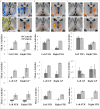Abnormal subcortical activity in congenital mirror movement disorder with RAD51 mutation
- PMID: 30406765
- PMCID: PMC6223827
- DOI: 10.5152/dir.2018.18096
Abnormal subcortical activity in congenital mirror movement disorder with RAD51 mutation
Abstract
Purpose: Congenital mirror movement disorder (CMMD) is characterized by unintended, nonsuppressible, homologous mirroring activity contralateral to the movement on the intended side of the body. In healthy controls, unilateral movements are accompanied with predominantly contralateral cortical activity, whereas in CMMD, in line with the abnormal behavior, bilateral cortical activity is observed for unilateral motor tasks. However, task-related activities in subcortical structures, which are known to play critical roles in motor actions, have not been investigated in CMMD previously.
Methods: We investigated the functional activation patterns of the motor components in CMMD patients. By using linkage analysis and exome sequencing, common mutations were revealed in seven affected individuals from the same family. Next, using functional magnetic resonance imaging (fMRI) we investigated cortical and subcortical activity during manual motor actions in two right-handed affected brothers and sex, age, education, and socioeconomically matched healthy individuals.
Results: Genetic analyses revealed heterozygous RAD51 c.401C>T mutation which cosegregated with the phenotype in two affected members of the family. Consistent with previous literature, our fMRI results on these two affected individuals showed that mirror movements were closely related to abnormal cortical activity in M1 and SMA during unimanual movements. Furthermore, we have found previously unknown abnormal task-related activity in subcortical structures. Specifically, we have found increased and bilateral activity during unimanual movements in thalamus, striatum, and globus pallidus in CMMD patients.
Conclusion: These findings reveal further neural correlates of CMMD, and may guide our understanding of the critical roles of subcortical structures for unimanual movements in healthy individuals.
Conflict of interest statement
The authors declared no conflicts of interest.
Figures


Similar articles
-
RAD51 deficiency disrupts the corticospinal lateralization of motor control.Brain. 2013 Nov;136(Pt 11):3333-46. doi: 10.1093/brain/awt258. Epub 2013 Sep 20. Brain. 2013. PMID: 24056534
-
Congenital mirror movements: phenotypes associated with DCC and RAD51 mutations.J Neurol Sci. 2015 Apr 15;351(1-2):140-145. doi: 10.1016/j.jns.2015.03.006. Epub 2015 Mar 10. J Neurol Sci. 2015. PMID: 25813273
-
Neural function in DCC mutation carriers with and without mirror movements.Ann Neurol. 2019 Mar;85(3):433-442. doi: 10.1002/ana.25418. Epub 2019 Feb 4. Ann Neurol. 2019. PMID: 30666715 Free PMC article.
-
Neurophysiology of unimanual motor control and mirror movements.Clin Neurophysiol. 2008 Apr;119(4):744-62. doi: 10.1016/j.clinph.2007.11.047. Epub 2008 Jan 9. Clin Neurophysiol. 2008. PMID: 18187362 Review.
-
Activation likelihood estimation meta-analysis of motor-related neural activity after stroke.Neuroimage. 2012 Feb 1;59(3):2771-82. doi: 10.1016/j.neuroimage.2011.10.023. Epub 2011 Oct 17. Neuroimage. 2012. PMID: 22023742 Review.
Cited by
-
Noncanonical Roles of RAD51.Cells. 2023 Apr 15;12(8):1169. doi: 10.3390/cells12081169. Cells. 2023. PMID: 37190078 Free PMC article. Review.
-
New candidate region for mirror hand movements: two patients with terminal 9p deletion and 20p duplication.Mol Biol Rep. 2024 Feb 1;51(1):243. doi: 10.1007/s11033-023-09192-9. Mol Biol Rep. 2024. PMID: 38300327
-
Mirror movements: mechanisms, diagnosis, and emerging therapeutic strategies.Acta Neurol Belg. 2025 Apr 29. doi: 10.1007/s13760-025-02795-y. Online ahead of print. Acta Neurol Belg. 2025. PMID: 40301278 Review.
References
-
- Mayston MJ, Harrison LM, Stephens JA. A neu-rophysiological study of mirror movements in adults and children. Ann Neurol. 1999;45:583–594. - PubMed
MeSH terms
Substances
LinkOut - more resources
Full Text Sources
Medical
Molecular Biology Databases
Research Materials

